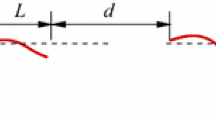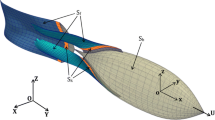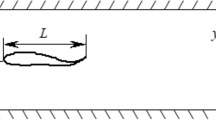Abstract
This paper presents a DSD/SST study of the hydrodynamic effects of mucus on swimming performance of an undulatory foil in a non-Newtonian uniform flow. As the non-Newtonian effects are dominant in the boundary layer, this model can be taken as a simple strategy to study the hydrodynamic effects of fish mucus. Based on the simulations by varying the power-law fluid behavior index, some propulsive properties including the drag coefficients, the power coefficients, and the flow fields are analyzed in detail. It is found that in addition to other biological functions, the fish mucus serves to reduce the friction, enhance the thrust, save hydrodynamic power, reduce the force oscillations, and reduce the swimming sound. This work provides a better understanding of the fish mucus effects from the point of view of hydrodynamics.








Similar content being viewed by others
References
Videler JJ (1993) Fish swimming. Chapman and Hall, London
Triantafyllou MS, Triantafyllou GS, Yue DKP (2000) Hydrodynamics of fish swimming. Annu Rev Fluid Mech 32:33–53
Fish FE, Lauder GV (2006) Passive and active flow control by swimming fishes and mammals. Annu Rev Fluid Mech 38:193–224
Tytell ED, Borazjani I, Sotiropoulos F, Baker TV, Anderson EJ, Lauder GV (2010) Disentangling the functional roles of morphology and motion in the swimming of fish. Integr Comput Biol 50:1140–1154
Deng HB, Xu YQ, Chen DD, Dai H, Wu J, Tian FB (2013) On numerical modeling of animal swimming and flight. Comput Mech 52:1221–1242
Ling SC, Ling TYJ (1974) Anomalous drag-reducing phenomenon at a water/fish-mucus or polymer interface. J Fluid Mech 65:499–512
Shephard KL (1994) Functions for fish mucus. Rev Fish Biol Fish 4:401–429
Müller UK, van den Heuvel BLE, Stamhuis EJ, Videler JJ (1997) Fish foot prints: morphology and energetics of the wake behind a continuously swimming mullet ( chelon labrosus risso). J Exp Biol 200:2893–2906
Roberts SD, Powell MD (2005) The viscosity and glycoprotein biochemistry of salmonid mucus varies with species, salinity and the presence of amoebic gill disease. J Comp Physiol B 175:1–11
Shadwick RE, Lauder GV (eds) (2005) Fish biomechanics. Academic Press, California
Helfman GS, Collette BB, Facey DF (2009) The diversity of fishes: biology, evolution and ecology, 2nd edn. Wiley, Chichester
Vatsos IN, Kotzamanis Y, Henry M, Angelidis P, Alexis M (2010) Monitoring stress in fish by applying image analysis to their skin mucous cells. Eur J Histochem 54:e22
Palstra AP, Planas JV (eds) (2013) Swimming physiology of fish: towards using exercise to farm a fit fish in sustainable aquaculture. Springer, Heidelberg
Nagamine H, Yamahata K, Hagiwara Y, Matsubara R (2004) Turbulence modification by compliant skin and strata-corneas desquamation of a swimming dolphin. J Turbul 5:1–25
Jakowska S (1963) Mucus secretion in fish. Ann NY Acad Sci 106:458–562
Negus VE (1963) The function of mucus. Acta Oto-Laryngol 56:204–214
Ingrain GA (1980) Substances involved in the natural resistance of fish to infection: a review. J Fish Biol 16:23–60
Ellis AE (1981) Non-specific defence mechanisms in fish and their role in disease processes. Dev Biol Stand 49:337–352
Daniel TL (1981) Fish mucus: in situ mearurements of polymer drag reduction. Biol Bull 160:376–382
Dean B, Bhushan B (2010) Shark-skin surfaces for fluid-drag reduction in turbulent flow: a review. Philos Trans R Soc A 368:4775–4806
Tezduyar TE, Behr M, Liou J (1992) A new strategy for finite element computations involving moving boundaries and interfaces: the deforming-spatial-domain/space-time procedure: I. The concept and the preliminary numerical tests. Comput Methods Appl Mech Eng 94:339–351
Tezduyar TE, Behr M, Mittal S, Liou J (1992) A new strategy for finite element computations involving moving boundaries and interfaces: the deforming-spatial-domain/space–time procedure: II. Computation of free-surface flows, two-liquid flows, and flows with drifting cylinders. Comput Methods Appl Mech Eng 94:353–371
Tezduyar TE (1992) Stabilized finite element formulations for incompressible flow computations. Adv Appl Mech 28:1–44
Mittal S, Tezduyar T (1992) A finite element study of incompressible flows past oscillating cylinders and airfoils. Int J Numer Methods Fluids 15:1073–1118
Tezduyar TE (2003) Computation of moving boundaries and interfaces and stabilization parameters. Int J Numer Methods Fluids 43:555–575
Tezduyar TE, Sathe S, Keedy R, Stein K (2006a) Space–time finite element techniques for computation of fluid–structure interactions. Comput Methods Appl Mech Eng 195:2002–2027
Tezduyar TE, Sathe S, Stein K (2006b) Solution techniques for the fully-discretized equations in computation of fluid–structure interactions with the space–time formulations. Comput Methods Appl Mech Eng 195:5743–5753
Tezduyar TE (2006) Interface-tracking and interface-capturing techniques for finite element computation of moving boundaries and interfaces. Comput Methods Appl Mech Eng 195:2983–3000
Tezduyar TE (2007) Finite elements in fluids: stabilized formulations and moving boundaries and interfaces. Comput Fluids 36:191–206
Tezduyar TE, Sathe S (2007) Modeling of fluid–structure interactions with the space–time finite elements: solution techniques. Int J Numer Methods Fluids 54:855–900
Wang SY, Tian FB, Jia LB, Lu XY, Yin XZ (2010) The secondary vortex street in the wake of two tandem circular cylinders at low Reynolds number. Phys Rev E 81:036305
Takizawa K, Tezduyar TE (2011) Multiscale space–time fluid–structure interaction techniques. Comput Mech 48:247–267
Takizawa K, Tezduyar TE (2012) Space–time fluid–structure interaction methods. Math Models Methods Appl Sci 22(supp02):1230001
Tian FB, Lu XY, Luo H (2012) Propulsive performance of a body with a traveling wave surface. Phys Rev E 86:016304
Bazilevs Y, Takizawa K, Tezduyar TE (2013) Challenges and directions in computational fluid–structure interaction. Math Models Methods Appl Sci 23:215–221
Takizawa K, Montes D, McIntyre S, Tezduyar TE (2013) Space–time VMS methods for modeling of incompressible flows at high Reynolds numbers. Math Models Methods Appl Sci 23:223–248
Dong GJ, Lu XY (2005) Numerical analysis on the propulsive performance and vortex shedding of fish-like travelling wavy plate. Int J Numer Methods Fluids 48:1351–1373
Yu C-L, Ting S-C, Yeh M-K, Yang J-T (2011) Three-dimensional numerical simulation of hydrodynamic interactions between pectoral-fin vortices and body undulation in a swimming fish. Phys Fluids 23:091901
Mittal S, Tezduyar TE (1995) Parallel finite element simulation of 3D incompressible flows-fluid–structure interactions. Int J Numer Methods Fluids 21:933–953
Johnson AA, Tezduyar TE (1999) Advanced mesh generation and update methods for 3D flow simulations. Comput Mech 23:130–143
Takizawa K, Henicke B, Puntel A, Kostov N, Tezduyar TE (2012a) Space–time techniques for computational aerodynamics modeling of flapping wings of an actual locust. Comput Mech 50:743–760
Takizawa K, Kostov N, Puntel A, Henicke B, Tezduyar TE (2012b) Space–time computational analysis of bio-inspired flapping-wing aerodynamics of a micro aerial vehicle. Comput Mech 50:761–778
Takizawa K, Henicke B, Puntel A, Kostov N, Tezduyar TE (2013) Computer modeling techniques for flapping-wing aerodynamics of a locust. Comput Fluids 85:125–134
Takizawa K, Henicke B, Puntel A, Spielman T, Tezduyar TE (2012) Space–time computational techniques for the aerodynamics of flapping wings. J Appl Mech 79:010903
Tian FB, Xu YQ, Tang XY, Deng YL (2013) Study on a self-propelled fish swimming in viscous fluid by a finite element method. J Mech Med Biol 13:1340012
Takizawa K, Tezduyar TE, Kostov N (2014) Sequentially-coupled space-time FSI analysis of bio-inspired flapping-wing aerodynamics of an MAV. Comput Mech 54:213–233
Takizawa K, Tezduyar TE, Buscher A (2015) Space–time computational analysis of MAV flapping-wing aerodynamics with wing clapping. Comput Mech 55:1131–1141
Tian FB (2015) A numerical study of linear and nonlinear kinematic models in fish swimming with the DSD/SST method. Comput Mech 55:469–477
Tian FB, Wang W, Wu J, Sui Y (2016) Swimming performance and vorticity structures of a mother–calf pair of fish. Comput Fluids 124:1–11
Stewart WJ, Tian FB, Akanyeti O, Walker C, Liao JC (2016) Refusing rainbow trout selectively exploit flows behind tandem cylinders. J Exp Biol 219:2182–2191
Xu YQ, Jiang YQ, Wu J, Sui Y, Tian FB (2018) Benchmark numerical solutions for two-dimensional fluid–structure interaction involving large displacements with the deforming-spatial-domain/stabilized space-time and immersed boundary-lattice Boltzmann methods. J Mech Eng Sci 232:2500–2514
Kalro V, Aliabadi S, Garrard W, Tezduyar T, Mittal S, Stein K (1997) Parallel finite element simulation of large ram-air parachutes. Int J Numer Methods Fluids 24:1353–1369
Tezduyar TE, Sathe S, Pausewang J, Schwaab M, Christopher J, Crabtree J (2008a) Interface projection techniques for fluid–structure interaction modeling with moving-mesh methods. Comput Mech 43:39–49
Tezduyar TE, Sathe S, Schwaab M, Pausewang J, Christopher J, Crabtree J (2008b) Fluid–structure interaction modeling of ringsail parachutes. Comput Mech 43:133–142
Takizawa K, Spielman T, Tezduyar TE (2011) Space–time FSI modeling and dynamical analysis of spacecraft parachutes and parachute clusters. Comput Mech 48:345–364
Takizawa K, Fritze M, Montes D, Spielman T, Tezduyar TE (2012) Fluid–structure interaction modeling of ringsail parachutes with disreefing and modified geometric porosity. Comput Mech 50:835–854
Takizawa K, Tezduyar TE (2012) Computational methods for parachute fluid–structure interactions. Arch Comput Methods Eng 19:125–169
Takizawa K, Spielman T, Moorman C, Tezduyar TE (2012) Fluid–structure interaction modeling of spacecraft parachutes for simulation-based design. J Appl Mech 79:010907
Takizawa K, Montes D, Fritze M, McIntyre S, Boben J, Tezduyar TE (2013a) Methods for FSI modeling of spacecraft parachute dynamics and cover separation. Math Models Methods Appl Sci 23:307–338
Takizawa K, Tezduyar TE, Boben J, Kostov N, Boswell C, Buscher A (2013b) Fluid–structure interaction modeling of clusters of spacecraft parachutes with modified geometric porosity. Comput Mech 52:1351–1364
Takizawa K, Tezduyar TE, Kolesar R, Boswell C, Kanai T, Montel K (2014a) Multiscale methods for gore curvature calculations from FSI modeling of spacecraft parachutes. Comput Mech 54:1461–1476
Takizawa K, Tezduyar TE, Boswell C, Kolesar R, Montel K (2014b) FSI modeling of the reefed stages and disreefing of the Orion spacecraft parachutes. Comput Mech 54:1203–1220
Takizawa K, Tezduyar TE, Kolesar R (2015a) FSI modeling of the Orion spacecraft drogue parachutes. Comput Mech 55:1167–1179
Takizawa K, Tezduyar TE, Boswell C, Tsutsui Y, Montel K (2015b) Special methods for aerodynamic-moment calculations from parachute FSI modeling. Comput Mech 55:1059–1069
Takizawa K, Tezduyar TE, Terahara T (2016) Ram-air parachute structural and fluid mechanics computations with the space–time isogeometric analysis (ST-IGA). Comput Fluids 141:191–200
Takizawa K, Tezduyar TE, Kanai T (2017) Porosity models and computational methods for compressible-flow aerodynamics of parachutes with geometric porosity. Math Models Methods Appl Sci 27:771–806
Kanai T, Takizawa K, Tezduyar TE, Tanaka T, Hartmann A (2019) Compressible-flow geometric-porosity modeling and spacecraft parachute computation with isogeometric discretization. Comput Mech 63:301–321
Tezduyar TE, Takizawa K, Brummer T, Chen PR (2011) Space-time fluid–structure interaction modeling of patient-specific cerebral aneurysms. Int J Numer Methods Biomed Eng 27:1665–1710
Takizawa K, Bazilevs Y, Tezduyar TE (2012a) Space–time and ALE-VMS techniques for patient-specific cardiovascular fluid–structure interaction modeling. Arch Comput Methods Eng 19:171–225
Takizawa K, Schjodt K, Puntel A, Kostov N, Tezduyar TE (2012b) Patient-specific computer modeling of blood flow in cerebral arteries with aneurysm and stent. Comput Mech 50:675–686
Takizawa K, Schjodt K, Puntel A, Kostov N, Tezduyar TE (2013) Patient-specific computational analysis of the influence of a stent on the unsteady flow in cerebral aneurysms. Comput Mech 51:1061–1073
Takizawa K, Bazilevs Y, Tezduyar TE, Long CC, Marsden AL, Schjodt K (2014a) ST and ALE-VMS methods for patient-specific cardiovascular fluid mechanics modeling. Math Models Methods Appl Sci 24:2437–2486
Takizawa K, Tezduyar TE, Buscher A, Asada S (2014b) Space–time fluid mechanics computation of heart valve models. Comput Mech 54:973–986
Takizawa K, Torii R, Takagi H, Tezduyar TE, Xu XY (2014c) Coronary arterial dynamics computation with medical-image-based time-dependent anatomical models and element-based zero-stress state estimates. Comput Mech 54:1047–1053
Takizawa K, Tezduyar TE, Terahara T, Sasaki T (2017) Heart valve flow computation with the integrated space–time VMS, slip interface, topology change and isogeometric discretization methods. Comput Fluids 158:176–188
Sasaki T, Takizawa K, Tezduyar TE (2019) Medical-image-based aorta modeling with zero-stress-state estimation. Comput Mech 64:249–271
Takizawa K, Henicke B, Tezduyar TE, Hsu M-C, Bazilevs Y (2011a) Stabilized space–time computation of wind-turbine rotor aerodynamics. Comput Mech 48:333–344
Takizawa K, Henicke B, Montes D, Tezduyar TE, Hsu M-C, Bazilevs Y (2011b) Numerical-performance studies for the stabilized space–time computation of wind-turbine rotor aerodynamics. Comput Mech 48:647–657
Bazilevs Y, Hsu M-C, Takizawa K, Tezduyar TE (2012) ALE-VMS and ST-VMS methods for computer modeling of wind-turbine rotor aerodynamics and fluid-structure interaction. Math Models Methods Appl Sci 22(supp02):1230002
Takizawa K, Tezduyar TE, McIntyre S, Kostov N, Kolesar R, Habluetzel C (2014) Space–time VMS computation of wind-turbine rotor and tower aerodynamics. Comput Mech 53:1–15
Bazilevs Y, Takizawa K, Tezduyar TE, Hsu M-C, Kostov N, McIntyre S (2014) Aerodynamic and FSI analysis of wind turbines with the ALE-VMS and ST-VMS methods. Arch Comput Methods Eng 21:359–398
Castorrini A, Corsini A, Rispoli F, Venturini P, Takizawa K, Tezduyar TE (2016) Computational analysis of wind-turbine blade rain erosion. Comput Fluids 141:175–183
Korobenko A, Bazilevs Y, Takizawa K, Tezduyar TE (2018) Computer modeling of wind turbines: 1. ALE-VMS and ST-VMS aerodynamic and FSI analysis. Arch Comput Methods Eng. Available online https://doi.org/10.1007/s11831-018-9292-1
Korobenko A, Bazilevs Y, Takizawa K, Tezduyar TE (2018) Computer modeling of wind turbines: 2. free-surface FSI and fatigue-damage. Arch Comput Methods Eng. Available online https://doi.org/10.1007/s11831-018-9287-y
Castorrini A, Corsini A, Rispoli F, Venturini P, Takizawa K, Tezduyar TE (2019) Computational analysis of performance deterioration of a wind turbine blade strip subjected to environmental erosion. Comput Mech
Takizawa K, Bazilevs Y, Tezduyar TE, Hsu M-C, Øiseth O, Mathisen KM, Kostov N, McIntyre S (2014) Engineering analysis and design with ALE-VMS and space–time methods. Arch Comput Methods Eng 21:481–508
Tezduyar TE, Takizawa K (2019) Space–time computations in practical engineering applications: a summary of the 25-year history. Comput Mech 63:747–753
Tian FB, Bharti RP, Xu YQ (2013) Deforming-spatial-domain/stabilized space-time (DSD/SST) method in computation of non-Newtonian fluid flow and heat transfer with moving boundaries. Comput Mech 53:257–271
Tian FB, Dai H, Luo H, Doyle JF, Rousseau B (2014) Fluid–structure interaction involving large deformations: 3D simulations and applications to biological systems. J Comput Phys 258:451–469
Wang L, Currao GMD, Han F, Neely AJ, Young J, Tian FB (2017) An immersed boundary method for fluid-structure interaction with compressible multiphase flows. J Comput Phys 346:131–151
Xu L, Tian FB, Young J, Lai JCS (2018) A novel geometry-adaptive Cartesian grid based immersed boundary-lattice Boltzmann method for fluid-structure interactions at moderate and high Reynolds numbers. J Comput Phys 375:22–56
Tian FB, Tobing S, Young J, Lai JCS, Walker SM, Taylor GK, Thomas ALR (2019) Aerodynamic characteristics of hoverflies during hovering flight. Comput Fluids 183:75–83
Ma J, Tian FB, Young J, Lai JCS (2019) Dynamic characteristics of a deformable capsule in a simple shear flow. Phys Rev E 99:023101
Wang L, Tian FB (2019) Numerical simulation of flow over a parallel cantilevered flag in the vicinity of a rigid wall. Phys Rev E 99:053111
Huang WX, Tian FB (2019) Recent trends and progresses in the immersed boundary method. J Mech Eng Sci Available online. https://doi.org/10.1177/0954406219842606
Tezduyar T, Aliabadi S, Behr M, Johnson A, Mittal S (1993) Parallel finite element computation of 3D flows. Computer 26:27–36
Johnson AA, Tezduyar TE (1994) Mesh update strategies in parallel finite element computations of flow problems with moving boundaries and interface. Comput Methods Appl Mech Eng 119:73–94
Johnson AA, Tezduyar TE (1996) Simulation of multiple spheres falling in a liquid-filled tube. Comput Methods Appl Mech Eng 134:351–373
Johnson AA, Tezduyar TE (1997a) Parallel computation of incompressible flows with complex geometries. Int J Numer Methods Fluids 24:1321–1340
Johnson AA, Tezduyar TE (1997b) 3D simulation of fluid-particle interactions with the number of particles reaching 100. Comput Methods Appl Mech Eng 145:301–321
Johnson A, Tezduyar T (2001) Methods for 3D computation of fluid-object interactions in spatially-periodic flows. Comput Methods Appl Mech Eng 190:3201–3221
Tian FB (2014) FSI modeling with the DSD/SST method for the fluid and finite difference method for the structure. Comput Mech 54:581–589
Shen L, Zhang X, Yue DKP, Triantafyllou MS (2003) Turbulent flow over a flexible wall undergoing a streamwise travelling wave motion. J Fluid Mech 484:197–221
Wu JZ, Ma HY, Zhou MD (2006) Vorticity and vortex dynamics. Springer, Berlin
Tian FB, Luo H, Zhu L, Lu XY (2011) Coupling modes of three filaments in side-by-side arrangement. Phys Fluids 23:111903
Lighthill MJ (1952) On sound generated aerodynamically. I. General theory. Proc R Soc Lond A 211:564–587
Barrett DS, Triantafyllou MS, Yue DPK, Grosenbaugh MA, Wolfgang MJ (1999) Drag reduction in fish-like locomotion. J Fluid Mech 392:183–212
Tian FB, Zhu L, Fok PW, Lu XY (2013) Simulation of a pulsatile non-Newtonian flow past a stenosed 2D artery with atherosclerosis. Comput Biol Med 43:1098–1113
Moulton JM (1960) Swimming sounds and the schooling of fishes. Biol Bull 119:210–223
Farassat F (2007) Derivation of formulations 1 and 1A of Farassat, NASA Tech. Rep. TM-2007-214853
Wang L, Tian FB (2018) Heat transfer in non-newtonian flows by a hybrid immersed boundary-lattice boltzmann and finite difference method. Appl Sci 8:559
Wang L, Tian FB (2019) Numerical study of flexible flapping wings with an immersed boundary method: fluid–structure–acoustics interaction. J Fluids Struct 90:396–409
Acknowledgements
Dr. F.-B. Tian is the recipient of an Australian Research Council Discovery Early Career Researcher Award (Project Number DE160101098). Simulations were partially undertaken with computational resources on the National Computational Infrastructure National Facility through the National Computational Merit Allocation Scheme supported by the Australian Government.
Author information
Authors and Affiliations
Corresponding author
Additional information
Publisher's Note
Springer Nature remains neutral with regard to jurisdictional claims in published maps and institutional affiliations.
Rights and permissions
About this article
Cite this article
Tian, FB. Hydrodynamic effects of mucus on swimming performance of an undulatory foil by using the DSD/SST method. Comput Mech 65, 751–761 (2020). https://doi.org/10.1007/s00466-019-01792-2
Received:
Accepted:
Published:
Issue Date:
DOI: https://doi.org/10.1007/s00466-019-01792-2




